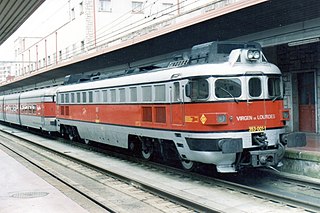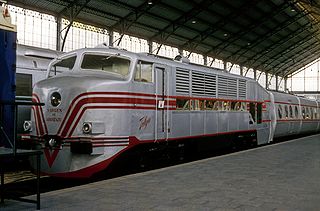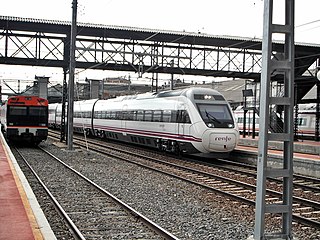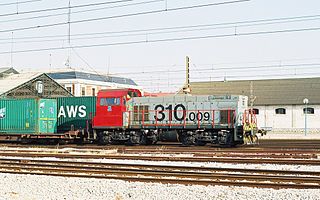| Renfe 309 | |||||||||||||||||||||||||||||
|---|---|---|---|---|---|---|---|---|---|---|---|---|---|---|---|---|---|---|---|---|---|---|---|---|---|---|---|---|---|
 309005 in October 2005 | |||||||||||||||||||||||||||||
| |||||||||||||||||||||||||||||
| |||||||||||||||||||||||||||||
| |||||||||||||||||||||||||||||
| |||||||||||||||||||||||||||||
The Renfe Class 309 is a class of 20 three axle diesel-hydraulic locomotives shunters built by M.T.M. for Renfe, and introduced between 1986-7.
| Renfe 309 | |||||||||||||||||||||||||||||
|---|---|---|---|---|---|---|---|---|---|---|---|---|---|---|---|---|---|---|---|---|---|---|---|---|---|---|---|---|---|
 309005 in October 2005 | |||||||||||||||||||||||||||||
| |||||||||||||||||||||||||||||
| |||||||||||||||||||||||||||||
| |||||||||||||||||||||||||||||
| |||||||||||||||||||||||||||||
The Renfe Class 309 is a class of 20 three axle diesel-hydraulic locomotives shunters built by M.T.M. for Renfe, and introduced between 1986-7.
In the late 1970s Renfe began planning to modernise its shunting locomotives; initially modernisation of the Class 303 with new engines was considered and one locomotive converted, but the experiment was not carried forward. In 1982 Renfe opened bidding for a contract for 50 locomotives of up to 1,100 hp (820 kW). M.T.M. ( Maquinista Terrestre y Marítima ) offered its own development, and was successful: in July 1983 Renfe placed an order for 20 units.
The first units were delivered in the red-brown/yellow/white estrella livery in 1985 and were accepted into service in 1986 after correction of technical problems.
Initially the property of Renfe, after the creation of Adif the locomotives were divided between Mercancías (formerly Cargas freight) and Adif (infrastructure services). As of 2010 about half have been painted in a red and grey livery. [4]

Renfe, officially Renfe-Operadora, is the national passenger railway company of Spain.

Ferrocarrils de la Generalitat Valenciana or FGV is a Valencian public railway company which operates several 1,000 mmmetre gauge lines, in the autonomous community of Valencia, Spain.

The Class 67 locomotives are a class of Bo-Bo diesel-electric locomotives that were built for the English Welsh & Scottish Railway (EWS) between 1999 and 2000 by Alstom at Meinfesa in Valencia, Spain with drive components from General Motors' Electro-Motive Division.

The Renfe 334 is a high speed, 4 axle diesel-electric locomotive built to haul passenger trains on Renfe's Talgo service on non electrified lines.

The Renfe Series 333 are high power six-axle diesel-electric locomotives built in the 1970s; at the time of their introduction they were the most powerful non-electric locomotives in Spain.

The Class 340 of Renfe were a class of 4-axle diesel-hydraulic locomotives built by Krauss-Maffei for the Spanish Railways. The design is similar in outward appearance and technology to the DB Class V 200. 32 units were built.

The Renfe Class 353, formerly known as the T-3000 are a class of diesel-hydraulic locomotives built by Krauss-Maffei for express trains in Spain.

The Renfe Class 352 was a class of twin engined four axle diesel-hydraulic locomotives built by Krauss-Maffei, designed solely for passenger traffic; in particular they were responsible for towing Andalusian Talgo III trains. The class were very successful, heralding a new era of passenger trains in Spain. They were delivered in 1964 and 1965, and were fully withdrawn during the 1990s.

The Renfe Class 354 was a series of eight diesel hydraulic locomotives manufactured by Krauss-Maffei in Germany specifically to pull Talgo pendular coaches which were introduced shortly before the acquisition of these machines.

The Renfe Class 350 is a series of four single-cabin diesel locomotives that were delivered to Spain in 1950 for use with Talgo II coaches, being built in the United States by the American Car & Foundry to a distinctly American external style.

The Renfe Class 130 or S-130 is a high-speed dual-gauge, dual-voltage trainset consisting of 11 Talgo VII tilting coaches and two power cars, used on Alvia and Euromed services. The class have been nicknamed patitos (ducklings), due to the shape of the train nose.

The Renfe Class 120 are electric multiple units used on Alvia high-speed rail services in Spain. Based on a family trains CAF Cepia.

The Renfe Class 252 are a series of Bo'Bo' electric locomotives, built by CAF, Meinfesa, Siemens and Krauss-Maffei for RENFE. 15 units were built for the AVE Madrid–Seville high speed line in, and 60 units constructed for general use to Iberian gauge (1668mm).

The Renfe classes 319.2, 319.3 and 319.4 are six axle Co'Co' medium power mainline diesel-electric locomotives manufactured by Macosa using General Motors Electromotive division components under license.

The Renfe Class 310 is a class of 60 four axle Bo'Bo' diesel-electric locomotives for shunting and freight built by Meinfesa with General Motors Electromotive Division components.

The Renfe Class 311 is a class of four axle Bo'Bo' diesel electric shunting and light freight locomotives.

Vigo railway station, also known as Vigo-Urzáiz, is a railway terminus in Vigo, Spain. It provides high speed train connection through the Atlantic Axis high-speed rail line with main Galician cities as Pontevedra, Santiago de Compostela and A Coruña every hour. The station is directly connected through the bus stop in Urzaiz street with the Airport and the Bus Station. There is a taxi stop in front of the station.

The Série 1320 were a class of diesel locomotives used by Portuguese Railways (CP). All have now been withdrawn from service.

The Renfe 313 was a class of 6 axle mainline diesel-electric locomotives built for Renfe by Euskalduna under license from Alco. 50 units were built in the mid-1960s, locomotives surplus to Renfe's requirements were sold to Comboios de Portugal (CP), Trenes de Buenos Aires, Argentina, and to the railway company of Minero Siderúrgica de Ponferrada.

The Renfe Class 321 is a class of diesel-electric locomotives operated by Renfe in Spain, designed by Alco and built by them and by Euskalduna under licence.